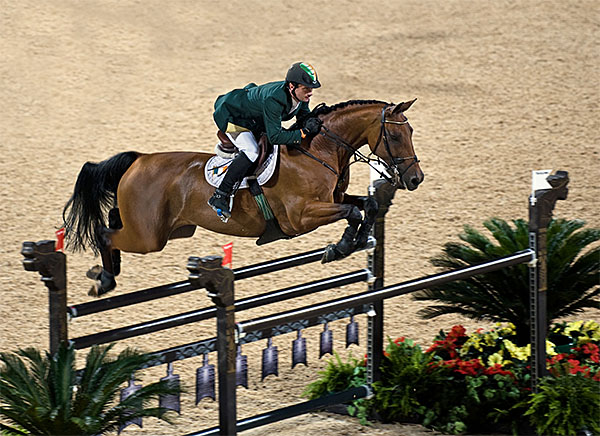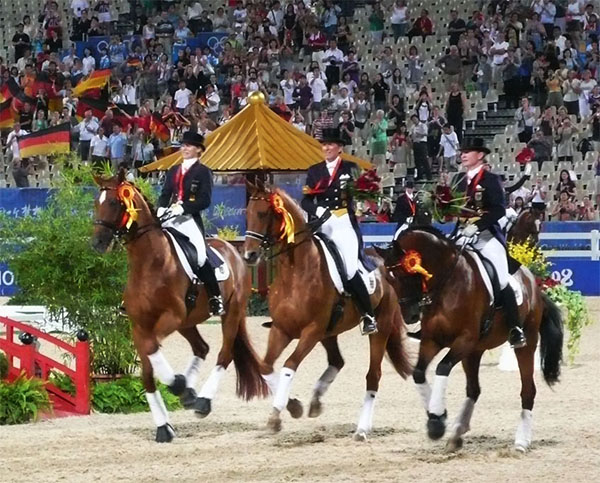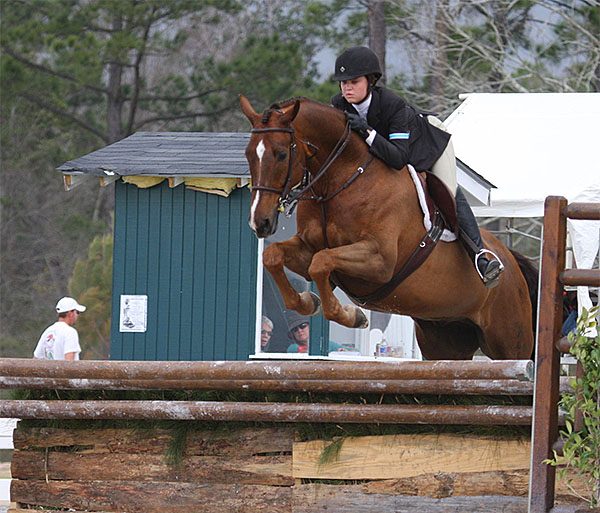Hanoverian Breed
(source: Wikipedia)
A Hanoverian is a warmblood horse breed originating in Germany, which is often seen in the Olympic Games and other competitive English riding styles, and has won gold medals in all three equestrian Olympic competitions. It is one of the oldest, most numerous, and most successful of the warmbloods. Originally a carriage horse, infusions of Thoroughbred blood lightened it to make it more agile and useful for competition. The Hanoverian is known for a good temperament, athleticism, beauty, and grace.
Breed History
In 1735, George II, the King of England and Elector of Hanover, founded the State Stud at Celle. He purchased stallions suitable for all-purpose work in agriculture and in harness, as well as for breeding cavalry mounts. The local mares were refined with Holsteiner, Thoroughbred and Cleveland Bay, Neapolitan, Andalusian, Prussian, and Mecklenburg stock. By the end of the 18th century, the Hanoverian had become a high-class coach horse.
In 1844, a law was passed that only allowed stallions that were passed by a commission to be used for breeding purposes. In 1867, breeders started a society aimed at producing a coach and military horse, with the first stud book being published in 1888. The Hanoverian became one of the most popular breeds in Europe for coach and army work.
When the demand for Hanoverians declined following World War I, the aim for breeding became a horse that could be used for farm work, but still had the blood and gaits to be used as a riding and carriage horse. After World War II, there was a growing demand for sport horses, as well as general riding horses, and the breeding yet again was adapted. Thoroughbreds were used to refine the breed; occasionally an Anglo-Arabian or Trakehner stallion was used. The key to the success of the Hanoverian has been the rigorous selection of breeding stock, a large breed population, and breeders' willingness to adapt to changes in demand.
Today, the Hanoverian breeders' association offers many incentives to breed the best, including the famous auctions at Verden, and extensive grading opportunities for stallions, mares and young horses. In addition, few breeds have such well-kept records, allowing breeders to trace bloodlines over many generations, improving their chances to find the best stallion–mare match. The current aim of breeders today is to create a noble, versatile warmblood with light, elastic, and ground-covering gaits. Whenever necessary, outside blood is brought in to improve the horse. The strict selection ensures that Hanoverians are athletic and good jumpers, for show jumping and eventing, and have the gaits for dressage.
Breed Characteristics
Hanoverians are elegant, strong, and robust. They are bred to be willing and trainable, and have a strong back, powerful body, athletic movement, and strong limbs. Chestnut, bay, black, and gray are found the most often. Regulations prohibit horses with too much white, and buckskin, palomino and cremello horses from being registered. The horses can be 15.3–17.2 hands (63–70 inches, 160–178 cm) high, but most are in the range of 16–16.2 hands (64–66 inches, 163–168 cm).
Hanoverians in Dressage
The Hanoverian Society has been the most successful studbook in international dressage competition as ranked by the WBFSH and FEI since these standings began to be published in 2001. The top Hanoverian-branded international dressage horses include Salinero, Satchmo 78, Sunrise, Bonaparte 67, Brentina, and Wansuela Suerte. Since the 1956 Olympic Games, Hanoverians have earned 3 individual gold medals (Salinero twice, and Gigolo), 4 individual silver medals (Satchmo, Gigolo twice, and Woycek), and 4 individual bronze medals (Bonaparte, Weyden, Mehmed, and Dux). Hanoverians have been members of no fewer than 7 gold medal dressage teams (2008, 2004, 2000, 1996, 1992, 1976, 1968, and 1964). The World Equestrian Games, which are held every four years to split the non-Olympic years evenly, have also been won by many Hanoverians. Dressage champions at the World Equestrian Games that bore the Hanoverian brand include Mehmed (1974), Gigolo (1994, 1998), Satchmo (2006), and Salinero (2006, freestyle). Hanoverians have been members of 8 gold-medal winning WEG teams since 1966 (1966, 1974, 1978, 1982, 1990, 1994, 1998, and 2006). At the age of 25, the Hanoverian stallion Weltmeyer is the world's #3 sire of international-caliber dressage horses, behind #2 Donnerhall, who was sired by the Hanoverian Donnerwetter.
Hanoverians in Showjumping
The Hanoverian Society has been consistently ranked in the top five most successful studbooks in international show jumping competition as ranked by the WBFSH and FEI since 2001.[2] The best Hanoverian jumpers of the new millennium are Shutterfly, by Silvio, and For Pleasure, by Furioso II. Shutterfly won the Show Jumping World Cup in 2005, 2008, and 2009. For Pleasure was second place at the 1995 World Cup, and was a member of two gold medal-winning Olympic show jumping teams. Warwick Rex won the individual gold medal in show jumping at the 1976 Montreal Olympics, and Fidelitas took silver at the 1964 Tokyo Games. Hanoverians have been members of 6 Olympic gold medal teams in show jumping (2000, 1996, 1992, 1988, 1964, 1960). Other top-notch Hanoverian show jumpers include winner of the 1995 World Cup Dollar Girl, two-time World Cup champion E.T. FRH, and Esprit FRH, vice-champion of the World Cup in 1998 and member of the gold medal-winning show jumping team at the 1998 World Equestrian Games in Rome.
Hanoverian in Hunters
Hanoverians often have the steady temperament and round jumping style required of show hunters.
Show hunters are subjectively judged over at least two separate patterns of rustic obstacles, and are also judged on the efficiency and correctness of their gaits. Conformation hunters are also judged on their conformation, or the suitability and correctness of their physique. Over fences, hunters must jump safely and predictably, pulling their legs away from the obstacle and using their hindquarters for propulsion. The best hunters are pleasant and uncomplicated to ride. Competitions for show hunters are uncommon outside the United States and Canada. These competitions are broken down based on the age and presumed ability level of the rider: "juniors" are riders under the age of 18, and they are divided into those riders 15 years old and younger, and those that are 16 or 17. The divisions for junior riders also feature either large (at least 16 hands (64 inches, 163 cm) tall) or small horses. Amateur adult riders compete in divisions for those 18 to 35 years, and those over 35. Champion hunters with the Hanoverian brand from recent years include Renaissance, Regular Working Hunter Horse of the Year in 2008, Katcha' Lookin', who was nationally ranked in top ten Regular Working Hunters in 2007, 2006, and 2005, and Sequel, Regular Working Hunter Horse of the Year in 2006 and 2005. Horse of the Year titles have also gone to Hanoverians in the restricted divisions, such as Large Junior Hunter 16-17 in 2008, Amateur Owner Hunter 18-35 and Amateur Owner Hunter 35+ in 2006, and Green Conformation Hunter in 2006. While poor record-keeping on the part of sellers and buyers limits their potential accuracy, the United States Equestrian Federation also publishes annual rankings of sires of hunter horses. In 2008, four Hanoverian sires were ranked in the top 10: All the Gold (2), Rio Grande (4), Escudo I (5) and Espri (8).
Hanoverians in Eventing
The sport of eventing is descended from comprehensive tests of cavalry horses, which had to be able to cover uncertain terrain and obstacles at speed, while still highly trained and obedient. The latter aspect is tested with a dressage test, while a grueling day of cross country jumping and galloping, followed by a simple show jumping course the next day, test the former quality. As civilians took up the sport following World War I, the sport began to demand faster horses. Over time, Hanoverians have become more successful in eventing. The development of the "short format" event, which does not require as much galloping, as well as the efforts of a handful of Hanoverian breeders, have seen the breed advance in the sport. An especially influential breeder of Hanoverian eventers is Friedrich Butt, whose crossing of Hanoverian half-Thoroughbred mares back to Thoroughbred stallions has produced the likes of Butts Abraxxas and the full siblings Butts Leon and Butts Leoness. Both Abraxxas and Leon were members of the gold medal-winning eventing team at the 2008 Beijing Olympics.
In 2008, the World Breeding Federation for Sport Horses (WBFSH) ranked the Hanoverian studbook third for eventing horses, behind the Irish Sport Horse and Selle Français. Thoroughbreds actually dominate the sport, and unregistered part-Thoroughbreds are also common, but as the breed registries for the Thoroughbred do not declare sport horses as their breeding aim, they are not members of the WBFSH and thus are not part of these rankings. Top sires of international-caliber Hanoverian eventers include Heraldik xx, Thoroughbred sire of Butts Leon and Butts Abraxxas; Amerigo Vespucci xx, Thoroughbred sire of Air Jordan and Nebelwerfer; Lemon xx, Thoroughbred sire of Lady Lemon FRH and FRH Little Lemon; and Sherlock Holmes xx, Thoroughbred sire of Schorsch and FRH Serve Well.



